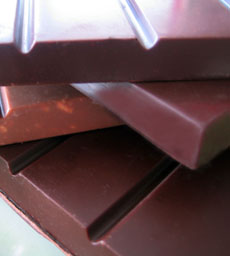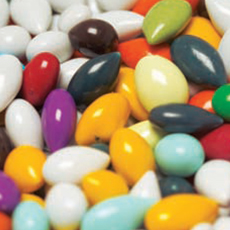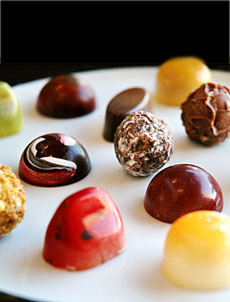
Enrobed chocolates from CafeBlancUS.com.
Last Updated May 2018 |
Product Reviews / Main Nibbles / ChocolateAll Types Of ChocolateTerms & Definitions: D & E
Here you’ll find terms like dark chocolate, dark milk chocolate and drinking chocolate. If you think we should consider chocolate terms and definitions other than those we have provided, click on the Contact Us link on this page. Also enjoy our many other food glossaries. Click on a letter to go to the appropriate glossary page. a b c d e f g h i j k l m n o p q r s t u v w x y z This glossary is protected by copyright and cannot be reproduced in whole or part.
DECORATIONThe finishing stage of creating a bonbon or praline, where special patterns, halved walnuts or other nut embellishment, piped gianduja, etc. are added to the tops of the chocolates. DEODORIZATIONA manufacturing process where the cocoa butter’s characteristic chocolate flavors are removed. While quality companies deodorize their cocoa butter to manufacture characteristic white chocolate, this process enables lesser companies to use poor quality and alkali-treated beans, which would produce unpleasant cocoa butter if not deodorized. See cocoa butter. DESIGNATED ORIGIN CHOCOLATEChocolate made from beans from a specific locale. Also called origin chocolate and single origin chocolate. See our reviews of single origin chocolate. DIAMANTThe French word for diamond, it refers to diamond-shaped chocolates. DIPPINGDipping is one of the four basic methods four basic methods of coating chocolate onto a center such as a caramel, nut or fruit; it was the original method of making coated chocolates and is done by hand by artisan producers. The other methods are enrobing, panning and molding or shell molding. DUTCH PROCESS COCOA or DUTCH CHOCOLATE
|
|
In fact, the alkali are a processing agent, not a flavor ingredient: The alkali changes the pH of the cocoa, neutralizing cacao’s natural acidity and making it milder in flavor than non-Dutched, natural cocoa (after Dutching, the pH may rise from 5.5 to 7 or 8). Because the pH is changed, you should not substitute the two types of cocoas without making some corrections. Especially in baking, leavening reactions may vary because of the change in the acidity. Note, however, that Dutched cocoa does not mean “the best cocoa.” Cocoa made from superior beans does not have the high acid and bitterness of typical Forastero beans used to make cocoa, and thus does not need to be Dutched. As a result, the inherent fruitiness and full flavor of the cacao bean can emerge. Fine bakers may choose un-Dutched cocoa from top manufacturers to bring out the best chocolate flavors in their baked goods. Scharffen Berger is one producer of top-quality un-Dutched cocoa. If you’re drinking cocoa for the flavanols (anti-oxidants), choose an un-Dutched product: Dutching destroys the phytochemicals. Top quality cocoa generally is not Dutched. As a result, the inherent fruitiness and full flavor of the cacao bean can emerge in the cocoa. Fine bakers may choose un-Dutched cocoa from top manufacturers to bring out the best chocolate flavors in their baked goods. Mass-market cocoa is typically made from high acid and bitterness Forastero beans. |
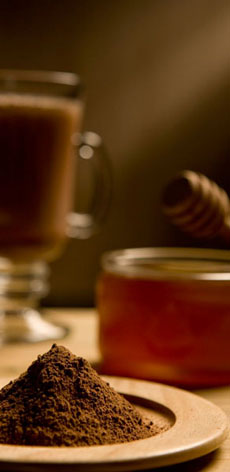 Cocoa powder. Photo courtesy Epullen. |
DUTCHING
The process of making Dutched cocoa from natural cocoa.
EATING CHOCOLATE
Chocolate in bar or other form for eating (as opposed to drinking chocolate, or cocoa, or cooking chocolate). Originally, chocolate was a beverage, made by grinding cacao beans and mixing them with liquid and spices. Over time, cocoa powder was invented and used in cooking as well as beverages. It was not until 1847 that “eating chocolate,” or the chocolate bar, was created.
ENROBINGCovering a chocolate, or the intended center of a chocolate like a ganache interior, with a thin layer of tempered (liquid) chocolate. This can be done by hand or by an enrober, a machine on which the centers (caramels, creams, ganaches, fruits, etc.) travel on a conveyer belt, are showered in a liquid stream of tempered chocolate, and then pass through a cooling tunnel so the chocolate can set. A gentle vibration allows the chocolate to be distributed evenly, giving it that perfect glossy coating. “Robe” means “dress” in French; the enrober is therefore dressing the centers. Enrobing is one of the four basic methods four basic methods of coating chocolate onto a center. The other methods are dipping, panning and molding or shell molding. |
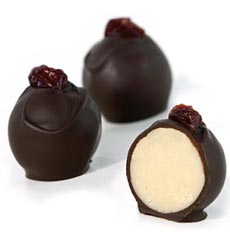 Enrobed chocolates from TheChocolatorium.com. |
ESTATE-GROWN or SINGLE ESTATE
Beans from a single plantation or hacienda.
Continue To Next Page: Terms With F
Go To The Alphabet Index Above
Lifestyle Direct, Inc. All rights reserved. Images are the copyright of their respective owners.
![]()
Last Updated May 2018
© Copyright 2005-2025 Lifestyle Direct, Inc. All rights reserved. All images are copyrighted to their respective owners.
